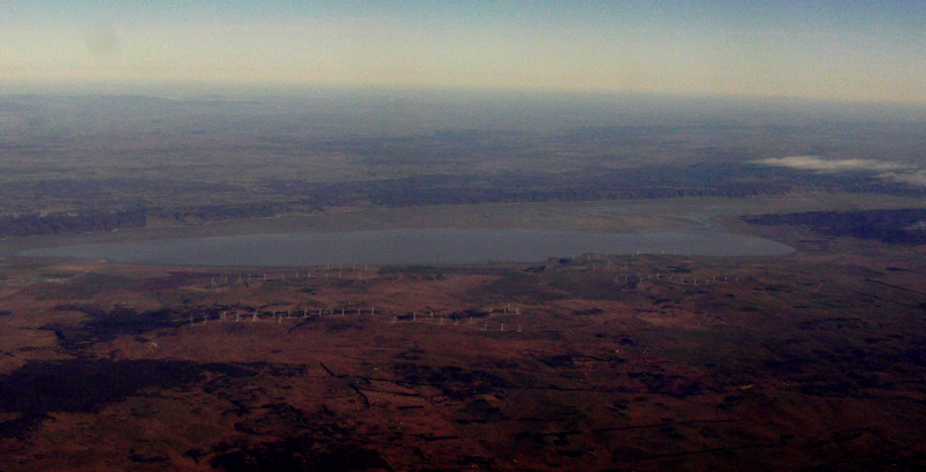We now know that Treasurer Joe Hockey is not a fan of wind farms, on aesthetic grounds at least. On Friday he told Macquarie Radio’s Alan Jones he finds the view “utterly offensive” and “a blight on the landscape”.
The vista that has so irked Mr Hockey can be seen while driving along the Federal Highway on the western side of Lake George. Across the water, dotted along the lake’s eastern shore, are turbines belonging to the Capital Wind Farm, the largest of six wind farms now operating to the north and northeast of Canberra.

The bad news for the Treasurer is that the Australian Capital Territory is one of the few places where wind farms are a growth industry, and are set to remain so regardless of what happens to the federal Renewable Energy Target.
Windy city
The area north of Canberra has some of the best wind resources anywhere in Australia. Since it was commissioned in 2011, the Gunning Wind Farm, about 70 km north of the capital, has consistently achieved a capacity factor (the ratio of power generated, relative to the facility’s theoretical maximum) of 40%, making it one of the best-performing wind farms in the country and, indeed, the world.
Unsurprisingly, there are several more wind farms planned for the area around Canberra – some quite advanced in the planning process. The total capacity of these projects is more than 1,000 megawatts. For comparison, the total capacity of operating wind farms currently supplying the National Electricity Market is just over 2,300 MW.
Power and certainty
However, like many wind farm projects at a similar stage of development around Australia, most of the projects in the Canberra region, including some which have received planning approval, are yet to sign a power purchase agreement with an electricity retailer or other party. This means that they do not have the financial certainty needed to start construction.
The main purchasers of wind-generated electricity are electricity retailers which, until now, have been legally required to buy a specified (and increasing) quantity of renewable electricity each year up to 2020 under the Renewable Energy Target (RET) scheme. Most retailers already have contracts in place for all the renewable electricity they need now and for at least the next year. In normal circumstances, retailers would be signing up new supplies of renewable electricity to cover their growing obligations from 2016 onwards.
Circumstances, however, are not normal. The RET scheme is undergoing its second review in two years, and several ministers – including Mr Hockey – have expressed what can only be described as extreme scepticism about the scheme’s merits. Many backbenchers and influential advisers are openly hostile to it.
ACT embracing wind power
Perhaps Mr Hockey thinks that winding back the RET scheme will ensure that no more wind farms appear to blight the view from his car. But unfortunately for him, the one area where new wind farms may continue to be built, even if the RET is scrapped, is around Canberra.
Earlier this year, the ACT government called for tenders to supply 200 MW of wind generation, as a major step towards its target of sourcing 90% of the territory’s electricity use from renewable sources.
The electricity generated by the contracted wind farms would not be supplied explicitly to the ACT. It will be fed into the National Electricity Market (NEM), where it will displace other sources that would otherwise be required to meet the territory’s power demand. But the ACT wind contracts will not be registered under the RET scheme because the territory’s government is aiming to make extra reductions in overall emissions, even if the nationwide RET scheme survives in something like its present form.
The tender documents state that the selected wind farm(s) may be located anywhere within the NEM, but also that tenderers will have to deliver economic benefits to the ACT. The territory government clearly expects that successful bidders will have projects close to Canberra.
Powering into the future
The ACT government has said that it will eventually commission about 382 MW of wind and 91 MW of solar generation, which, together with some smaller renewable sources, should be sufficient to achieve the 90% target. This target is a core element of the territory’s legislated plan to cut greenhouse emissions, including from power stations supplying the ACT with electricity, by 40% relative to 2000 levels by 2020.
This makes the ACT unique among Australia’s state, territory and federal governments. It is the only one with a legislated emissions-reduction target and a credible plan to make it happen.
Unlike the rest of Australia, the ACT has negligible emissions from industry, agriculture, forestry and land use changes – the majority of its emissions come from from electricity generation and transport. The government has concluded that it will be hard to make major reductions in emissions from transport fuels by 2020, but much easier to cut electricity-generation emissions. So making deep cuts in electricity emissions would be the cheapest way to hit the overall emissions target.

While the current tender is the first for wind generation, the ACT government has already contracted 40 MW of large-scale solar power. The first contracted project, the 20 MW Royalla Solar Farm, is almost finished and will soon be up and running. It’s about 20 km south of Canberra along the Monaro Highway, and is easy to spot from a car.
Let’s hope, if Mr Hockey drives that way, that he prefers looking at solar panels rather than wind turbines.

